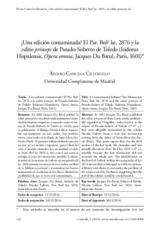¿Una edición contaminada? El Par. BnF lat. 2876 y la editio princeps de Pseudo-Sisberto de Toledo (Isidorus Hispalensis, Opera omnia, Jacques Du Breul, París, 1601)
A Contaminated Edition? The Manuscript Paris, BnF lat. 2876 and the editio princeps of Pseudo-Sisbert of Toledo (Isidorus Hispalensis, Opera omnia, Jacques Du Breul, Paris, 1601)
Autor
Cancela Cilleruelo, Álvaro
Editor
Universidad de Córdoba, UCOPressFecha
2016Materia
Du Breul, JacquesSisberto de Toledo
Lefèvre, Nicolas
Par. BnF lat. 2876
Saint-Maur-des-Fossés
METS:
Mostrar el registro METSPREMIS:
Mostrar el registro PREMISMetadatos
Mostrar el registro completo del ítemResumen
En 1601 Jacques Du Breul publicó la
editio princeps de tres obras tradicionalmente consideradas
hispano-visigodas y conocidas como el corpus
de Pseudo-Sisberto de Toledo (ss. vii-ix); para
su publicación, el filólogo Nicolás Lefèvre transcribió
supuestamente un solo códice, hoy perdido,
otrora conservado en la abadía de Saint-Maur-des-
Fossés (París). El presente trabajo defiende que, por
ser este tal vez mútilo o lagunoso, para el final del
texto el modelo transcrito fue, en realidad, el códice
París, BnF lat. 2876 (s. xii), con el que acaso se
corrigió el texto del manuscrito perdido; la identificación
de la escritura de Lefèvre en marginalia del
lat. 2876 permite reconocer en este códice un libro
de su biblioteca personal y reconsiderar las fuentes
manuscritas de la edición de Du Breul, abriendo la
posibilidad de que su texto esté contaminado. In 1601 Jacques Du Breul published
the editio princeps of three Latin works traditionally
regarded as Visigothic, today known as the
corpus of Pseudo-Sisbert of Toledo (7th-9th c.);
they were allegedly transcribed by the scholar
Nicolas Lefèvre from a now lost manuscript
coming from the abbey of Saint-Maur-des-Fossés
(Paris). This paper argues that, for the final
section of the last work, the exemplar used was
actually the extant Paris, BnF lat. 2876 (12th c.),
possibly because the lost manuscript did not
transmit the whole text. The identification of
the hand of Lefèvre within the marginalia of lat.
2876 proves that it belonged to Lefèvre’s personal
library and allows to reconsider the problem of
the sources used by Du Breul, suggesting that the
text of his edition could be contaminated.

